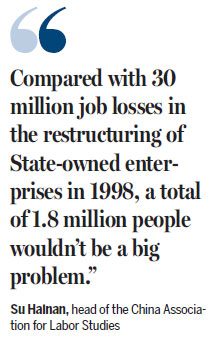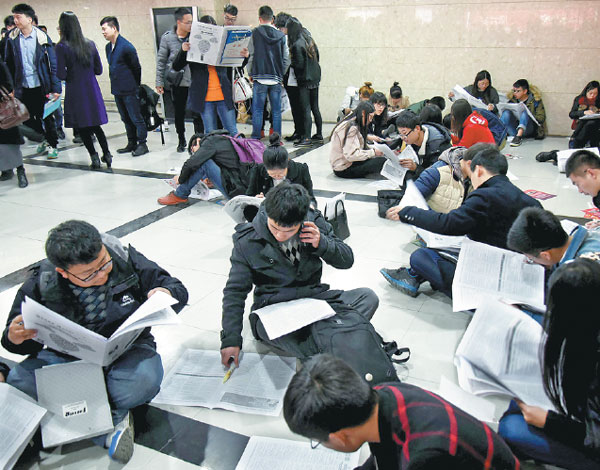China meets all but one State goal
Updated: 2016-03-02 08:18
By Wang Yanfei(China Daily)
|
||||||||
But structural changes will lead to layoffs in traditional industrial sectors
A review of China's accomplishments during the 12th Five-year Plan (2011-15) shows remarkable progress amid the country's transition to healthier and more sustainable economic growth.
China achieved 24 of 25 goals set at the beginning of 2011, and many were accomplished ahead of schedule and exceeded their targets, the State Council reported on Tuesday.
|
Job seekers check recruitment information at a spring job fair held last week in Hangzhou, Zhejiang province. Shi Jianxue / For China Daily |
A 96 percent success rate is "good enough" amid downward economic pressures, said Hu Angang, an economics professor at Tsinghua University, who cited fluctuations in the world economy for the only problem area in the plan, China's failure to realize a 6 percent annual growth rate for imports and exports.
One notable achievement was the 13.12 million new jobs generated for urban residents, far exceeding the target of 10 million.
Concerns have been raised, however, over a coming wave of job losses as the country makes significant structural changes, especially in traditional manufacturing and industrial sectors.
Although layoffs are inevitable, they will "not pose great challenges to the overall employment in the next couple of years", said Su Hainan, head of the China Association for Labor Studies, a government think tank.
Layoffs in the coal and steel sectors could number 1.8 million, said Yin Weimin, minister of human resources and social security.
"Compared with 30 million job losses in the restructuring of State-owned enterprises in 1998, a total of 1.8 million people wouldn't be a big problem," Su said. "China is capable of dealing with layoffs and it will not turn into a long term social issue."

Employment during the 13th Five-year Plan period (2016-20) should remain stable, as long as the economy stays within a reasonable range, Su said.
Su drew much confidence from the fast development of the service sector, which has become the new engine driving economic growth. The sector contributed 50.5 percent to the country's GDP last year, notably outperforming industrial production.
"The service sector has great potential to absorb more of the workers that are being shed," said Zheng Dongliang, director of the Work Science Research Institute at the Ministry of Human Resources and Social Security, noting that the service sector created more than 100 million jobs in the past 10 years.
Zheng predicted the sector will provide more than 50 percent of job opportunities by the end of 13th Five-year Plan period.
"In regions where the economy is expected to sustain a fast speed of growth, there will be a smooth transition, but for manufacturing hubs in the eastern part of China, laid-off workers might find it harder to get new jobs in the third sector, especially those elderly, poorly educated and unskilled workers," Zheng said.
Yi Dinghong, an economics professor at Renmin University of China in Beijing, recommended that the government provide more public service jobs and make good use of investments to deal with the expected layoffs.
The central government will allocate 100 billion yuan ($15.3 billion) in the next two years to relocate workers affected by the economy's structural reforms.
wangyanfei@chinadaily.com.cn
(China Daily 03/02/2016 page7)
- ROK conducts maritime drill for WMD carried by DPRK ships
- EU to propose emergency humanitarian aid to Greece
- Cuba intensifies fight to fend off Zika virus
- UN chief calls for 'prompt, impartial' probe into airstrike on Yemeni market
- Ex-Tepco execs indicted over Fukushima disaster
- British PM threatened with 'no confidence vote' over EU referendum

 China's first large passenger plane poised for maiden flight
China's first large passenger plane poised for maiden flight
 Clashes break out as France begins clearing Calais migrant camp
Clashes break out as France begins clearing Calais migrant camp
 Top 10 cities with most billionaires in 2016
Top 10 cities with most billionaires in 2016
 Milan Fashion Week: Dolce & Gabbana Autumn/Winter 2016 collection
Milan Fashion Week: Dolce & Gabbana Autumn/Winter 2016 collection
 Top moments from Oscars 2016
Top moments from Oscars 2016
 China Daily weekly photos: Feb 20-26
China Daily weekly photos: Feb 20-26
 People view plum blossoms at scenic area in E China
People view plum blossoms at scenic area in E China
 Rural e-commerce developed to promote local products in SW China
Rural e-commerce developed to promote local products in SW China
Most Viewed
Editor's Picks

|

|

|

|

|

|
Today's Top News
What ends Jeb Bush's White House hopes
Investigation for Nicolas's campaign
Will US-ASEAN meeting be good for region?
Accentuate the positive in Sino-US relations
Dangerous games on peninsula will have no winner
National Art Museum showing 400 puppets in new exhibition
Finest Chinese porcelains expected to fetch over $28 million
Monkey portraits by Chinese ink painting masters
US Weekly

|

|








